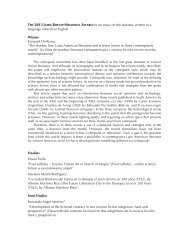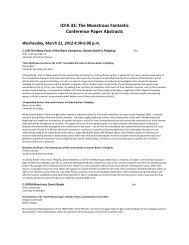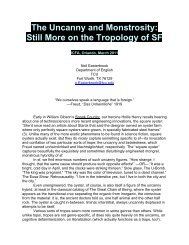Of all of the character transformations in the re-imagined television series Battlestar Galactica (BSG), Kara ‘Starbuck’ Thrace’s transformationfrom human being to monstrous ‘thing’ is the most remarkable production of otherness. <strong>The</strong> series depicts the ongoing conflict betweenhumanity and the Cylons, an artificially created race of robotic soldiers and ships, cyborg-like Hybrids and organic humanoids. After thestraightforward ‘human vs. machine,’ ‘us vs. them’ ideological positioning in the miniseries, the narrative in the following four seasonsincreasingly questions essentialist conceptions of identity. Within the complex web of relations that develops between humans and Cylons,many character transformations signal an interrogation of how beliefs in essential differences are naïve and promulgate untenable socialstructures—something audiences and critics alike have appreciated about the series. In contrast, Starbuck’s strange becoming renders herdistinct from everyone else, human and humanoid Cylon alike, because it is never clear what she becomes. As she is the character in the serieswho has been consistently presented as human in her compelling combination of flaws and talent, her change prompts questions about theeffects of her metamorphoses. In this paper, I argue that Starbuck is made monstrous in her transformation from human being to thing, andthis monstrosity functions as a catalyst that allows BSG to move back towards an ideology of difference in which an individual’s essential‘nature’ determines her or his personal and social identity.Classical Reception in Battlestar Galactica: Myths and Monsters in the Third MillenniumBeth Severy-HovenMacalester CollegeGlen Larson based his 1978-9 TV series Battlestar Galactica on stories from the Hebrew bible inflected by Mormonism: following catastrophe, apatriarchal commander leads survivors across a void toward a promised land. <strong>The</strong>se Colonials also use Greek and Egyptian names and imageryto hint at ancient contact with our earth. Appropriately for a Cold War story, the refugees’ enemies are godless – robotic Cylons created byalien reptiles. Intriguingly, in re-imagining this universe in 2003, Ronald Moore and David Eick dramatically redistribute ancient Mediterraneantraditions. Egyptian and biblical allusions are stripped from the Colonials, who worship a largely Greek pantheon. <strong>The</strong> Cylons are both rebelliouscreations of humans and monotheistic, and their belief in one God drives the genocidal attack on their creators which launches the plot. Usinga concept of ‘myth’ articulated by sociologist of nationalism Duncan Bell, I examine how the new series engages in myth-making, that is, howthe past projected into a technologically advanced future explores issues of identity in North America immediately post 9/11. In myth,says Bell (2003:76): “Time and place combine and are encoded...shaping the feelings of community and the construction of an inside/outsidedistinction, framing national identity in terms of a story about history and (a specific, often imagined) location.” Battlestar Galacticamanipulates the past to create complex, sometimes conflicting categories of us and them, members and monsters. In 2003 Cylon monotheistsavowing holy war are implicitly Islamic, whereas the Colonials are Western via their exclusive association with ancient Greece, the ‘birthplace ofWestern civilization’. But another narrative about these traditions complicates that identification, namely that Christianity triumphed overpolytheism, that monotheism is how ‘we’ evolved into ‘us’. Long before the finale cast the series as an origin myth, BSG was an active agent inwhat Bell would call the American mythscape.130. (H) <strong>The</strong> Medium is the Monster: Peter Straub PalmChair: Edward HowarthLongwood UniversityMonsters, Detectives and Prose Style in Peter Straub’s <strong>The</strong> Hellfire ClubJoe SandersShadetree ScholarFollowing the publication of the Blue Rose trilogy and of <strong>The</strong> Hellfire Club [1996], commentators assumed dispassionately (<strong>The</strong> Encyclopedia ofFantasy [1997]) or jubilantly (Joshi’s <strong>The</strong> Modern Weird Tale [2001]) that Peter Straub had turned from writing dark fantasy to detectivethrillers. Actually, Straub’s fiction has always been centered on uncanny intrusions into normal life, which his characters attempt to resolve inthe least distressing ways possible. Detective fiction actually is a kind of anti-horror fiction because it assumes that a persistent person whoconcentrates really hard can resolve anomalies in our experience, can even correct unpleasant or threatening situations, while horror assumesthat human understanding and control are impossible. But the detective’s assurance is frequently less than convincing. In fact, a lingeringdoubt of any person’s power to “solve” crimes and resolve doubts has always been part of detective fiction, from Sherlock Holmes’ errors in “AScandal in Bohemia” to such modern stories as Chester Himes’ Blind Man with a Pistol. Such uncertainty is a rich breeding ground for horror, inworks such as John Dickson Carr’s <strong>The</strong> Burning Court or John Connolly’s overwrought Charlie Parker novels. Straub’s “thrillers” lurk on theoutskirts of this territory, at the borders of the supernatural. <strong>The</strong> Hellfire Club’s prologue, “SHORELANDS, JULY 1938,” sets up levels ofperception for the reader. First, there are objects, physical things that can be put into lists; people would prefer to operate on this level, even ifthat means denying the implications of how they encounter such physical objects. <strong>The</strong>n there are other people, beings transformed byimagination into unsettling or “terrifying” creatures; encounters with them are to be put off as much as possible. This short narrative ispresented as solid fact, valuable information that the characters in the novel will assemble only gradually in the course of the action. Still,Straub uses the word “uncertain” twice in the first paragraph to describe the immediate observer and her observations. Appearing later in theaction, people who confidently offer interpretations are mistaken or lying. We are, in short, stuck in a world we don’t understand and arejustifiably wary of understanding better. People in that situation are bound to be victims of others who see more and who aren’t afraid ofexploiting their understanding. This is the condition of Nora Chancel, in the hands of preternaturally cunning Dick Dart. Eventually, Nora alsolearns to see and manipulate what she sees—but that does not change the threateningly inchoate nature of the world. In fact, Nora managesto conceptualize her situation in terms of ghosts, demons, and monsters. She could be right. Thus it is not a mistake to see <strong>The</strong> Hellfire Club interms of dark fantasy as we respond to the uncertainty Straub’s writing encourages throughout the novel, continuing his exploration of thelimits of human understanding. This hesitant, uncommitted style is perhaps the safest way to proceed in the presence of monsters.Machen a Mess: Deliquescent Monsters in Fiction by Stephen King, Arthur Machen and Peter StraubBernadette Boskey
Independent ScholarKing’s story “Gray Matter” and the end of Straub’s novel Ghost Story are both arguably influenced by the fiction of Arthur Machen, especially“<strong>The</strong> Great God Pan” and “<strong>The</strong> Novel of the White Powder.” In each, a creature – monster, semi-human, or human being under the influence ofa corrupting substance – melts in some way, often to a slimy liquid, and the change is implicitly or explicitly framed in terms of de-evolution.What does this image of the liquescent monster convey about our fears, about the body and identity? I connect both the sexual nature of theviscosity and its formlessness to an underlying fear about the integrity and dependability of our bodies as individual agents. I’ll use some of thefeminist/fat-studies material that examine how our culture values hard, masculine, impenetrable bodies and both devalues and fears soft,female, vulnerably open bodies; this material explicitly links the body issue to one of identity and need to defend our individual consciousness,and I will also examine that in the stories. “<strong>The</strong> Novel of the White Powder” and “Gray Matter” also show a fear of, yet attraction to, substanceabuse, while “<strong>The</strong> Great God Pan” and Ghost Story have more to do with gender and sexuality.<strong>The</strong> Gothic Heart of Real-World Horrors: Peter Straub’s Trio of Non-Supernatural NovelsRhonda Brock-ServaisLongwood UniversityIn his 1998 ICFA Guest of Honor talk, Peter Straub speaks of creating a “fictional space,” something “essentially unlocated…hover[ing] a littledistance off the ground” (165). Within this space, “certainty of any kind speaks of what is unexamined, unfelt, imagined – it is the spacebetween the received and the as yet unknown” (166). Clearly one could claim such a space and, thus Straub’s works, as Gothic because of theemphasis on the parallel existence of the understood and the incomprehensible. <strong>The</strong> Gothic is further known for its focus on the imaginary andthe supernatural. This, too, fits with Straub’s works, except when it doesn’t. <strong>The</strong> Blue Rose trilogy (Koko, Mystery, and <strong>The</strong> Throat) are notsupernatural novels; one could easily argue that with regard to genre they aren’t even horror novels, but rather mysteries or thrillers. Yet,these novels, at their heart, are Gothic, both by trope – the use of darkness, persecution -- and in philosophy and feel -- the importance of thepast, the prevalence of fate. In these works “anything like conclusions, answers and finalities no longer exist…[they] dissolve before their ownrigidity” (166). <strong>The</strong> Blue Rose trilogy demonstrates that perhaps the truest manifestation of the Gothic is not found in a haunted moor orcastle, but rather in the everyday experiences of individuals, be they characters or readers, who are coming to understand the “mysteriouspromise” of the world (166).131. (IF/H) <strong>International</strong> Human-Animal Hybrids and Transforming Monsters MagnoliaChair: Debbie FeltonUniversity of Massachusetts Amherst<strong>The</strong> Changing Shape of a Shape-Shifter: <strong>The</strong> French and French-Canadian Loup-garouAmy J. RansomCentral Michigan UniversityMarie de France’s late twelfth-century “Le Lai de Bisclavret,”with its sympathetic werewolf, remains today the best-known werewolf text inFrench literary history; in contrast with the medieval tradition of the courtly loup-garou, however, a much more malevolent form of the beastcrossed the Atlantic to thrive in the northern woods of New France, later Lower Canada, and now Québec. Like its French literary precursor, theFrench-Canadian loup-garou evolved from an oral tradition of folktales; it also engaged central questions of notions of civility versus barbarismand questions about sexuality and gender relations. Yet the French-Canadian werewolf developed in a completely new setting: that ofcolonizing a new world and the encounter with “savage” peoples and their lore about the territory now being explored and inhabited byEuropean newcomers. <strong>The</strong>n, in the context of early French-language nationalism in Lower Canada at the end of the nineteenth and thebeginning of the twentieth centuries, writers like Louis Fréchette, Honoré Beaugrand, Wenceslas Eugene Dick and Pamphile Le May began topublish literary versions of oral tales of the loup-garou, la chasse-galerie and other supernatural figures. At the same time that these writerswere exploiting the oral tradition in their construction of a French-Canadian national culture and identity, others in the United States, likeCaroline Watson Hamlin and Mary Hartwell Catherwood were documenting the fading presence of French-speaking populations in the GreatLakes region. Drawing on the ethnographical work of Carolyn Podruchny on the loup-garou in French-Canadian folklore and Carolyn WalkerBynum’s theorization of the werewolf as a figure of change, this paper teases out the nuances of meaning for the loup-garou tales published inNorth America, in French and in English, in these two distinct but related corpuses.<strong>The</strong> Sphinx, Fauns, and Satyrs: More Than Yet Not Quite HumanDon RiggsDrexel UniversityWhile the ancient Egyptians saw part-human part-animal beings as gods, like the bird-headed Horus and the lion-headed Sekhmet, the ancientGreeks and Romans saw the sphinx, fauns, and satyrs as demigods embodying the necessary but dangerous natural component of humans,sexuality. Freud had several antique images of the Sphinx in his study, of them, a Greek terracotta sculpture from south Italy, made in the 4 th -5 th century B.C.E., shows two prominent breasts jutting forth assertively, or perhaps provocatively. Satyrs are shown on 5 th century B.C.E. Greekvase paintings either chasing female followers of Dionysus, in one instance copulating doggy-fashion with a human woman or, in another,crumpling as a Maenad thrusts her thyrsus at his genitals. Fauns are similarly recorded as constantly in pursuit of nymphs, their goatish libidofrequently frustrated, as in Mallarmé’s 1876 poem L’apres-midi d’un faune. This frustrated libido climaxed in the initial choreography forDiaghilev’s ballet of Debussy’s Prélude a l’apres-midi d’un faune, where Vasily Nijinsky, dancing the part of the faun, masturbates—or simulatesmasturbation—at the end of the ballet. <strong>The</strong> Sphinx—at least, the Greek Sphinx associated with Oedipus and <strong>The</strong>bes—and the two half-male,half-goat or half-horse bipeds known as fauns and satyrs seem to be liminal figures that emphasize the human connection with nonhumannature through the sexual drive. Often ancient representations of fauns and satyrs, as well as some more modern versions, give them human
- Page 4 and 5:
5. (F) Wondrous Bodies of the Gende
- Page 6 and 7:
Fantastic Suicide: Reading the Unca
- Page 8:
Viral Posthumanism: Boundaries and
- Page 11 and 12:
The Concept of Soul Divisibility in
- Page 13 and 14:
Thursday, March 22, 2012 10:30 a.m.
- Page 15 and 16:
21. (CYA) Terrifying Futures: Post-
- Page 17 and 18:
23. (FTV/H) Now I’m Feelin’ Zom
- Page 19 and 20:
Fight Club: Amalgam of the Horrific
- Page 21 and 22:
Taking the Monsters out of the Clos
- Page 23 and 24:
Kaspar J. SaxenaIndependent Scholar
- Page 25 and 26:
44. (CYA) The Monstrosity of Teenag
- Page 27 and 28:
46. (FTV/SF) Monstrous Spin-offs: T
- Page 29 and 30: 49. (F) Aspects of Miéville Captiv
- Page 31 and 32: 53. (SF) War and Crisis in 1940s an
- Page 33 and 34: Abuse of Power: An Evolutionary Res
- Page 35 and 36: Disappearing Natives: The Colonized
- Page 37 and 38: 60. (H/IF) Ancient and Medieval Mon
- Page 39 and 40: 62. (F) The Works of Tolkien Captiv
- Page 41 and 42: 67. (SF) Imperial and Postcolonial
- Page 43 and 44: Beheading the Gorgon: Beautifying C
- Page 45 and 46: 71. (VPA) Monstrous Music MagnoliaC
- Page 47 and 48: 73. (F/IF) Portraying New Worlds Ca
- Page 49 and 50: Friday, March 23, 2012 2:45-3:45 pm
- Page 51 and 52: 81. (FTV) Those Damn Dirty Apes! Cy
- Page 53 and 54: Friday, March 23, 2012 4:00-5:30 pm
- Page 55 and 56: 92. (F) Leaving the Demonized Other
- Page 57 and 58: 94. (FTV/CYA) Monstrosity and Devia
- Page 59 and 60: of cannibalism, ghostly seduction i
- Page 61 and 62: Saturday March 24, 2012 8:30-10:00
- Page 63 and 64: 104. (CYA) Classic Monsters, Reinte
- Page 65 and 66: 107. (VPA) Monstrous Gaming Bodies
- Page 67 and 68: who challenge the order that the Br
- Page 69 and 70: Reading Between the Times: A Critic
- Page 71 and 72: 117. (FTV) Monsters and Superheroes
- Page 73 and 74: 119. (IF/H/PCS) International Mash-
- Page 75 and 76: Focusing on Stoker's Dracula as one
- Page 77 and 78: Florida Atlantic UniversitySheri S.
- Page 79: Simmons CollegeIn the spate of rece
- Page 83 and 84: modernity opens up for every indivi
- Page 85 and 86: Saturday March 24, 2012 4:00-5:30 p
- Page 87 and 88: 141. (FTV) Monstrous Masculinity Cy
- Page 89 and 90: ultimately make peace with her mons
- Page 91 and 92: where the almost-human sentient zom





